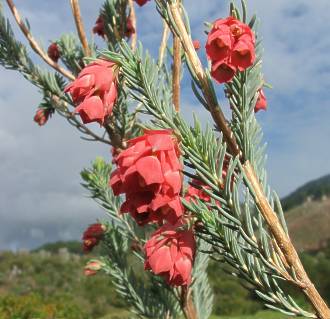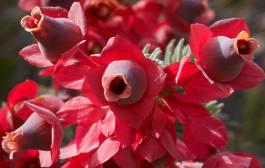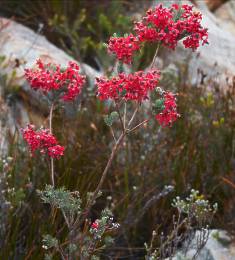Erica glauca var. glauca
Erica glauca Andrews var. glauca
Family: Ericaceae
Common names: cup-and-saucer heath (Eng.); kommetjiepieringheide (Afr.)
Introduction
The flowers of Erica glauca var. glauca are spectacular and most unusual for the genus in both construction and colour. The bracts and calyx are very large, a strikingly beautiful red, and dominate the corolla which is a dark plum colour.

Description
Description
Erica glauca is an erect, woody shrub growing up to at least 1 m and sometimes up to 2 m tall. It arises from a single woody stem and produces thin, sturdy branches ideal for supporting sunbirds that are attracted to its flowers. The exceptional feature of this plant is its spectacular flowers. They are made up of a combination of lovely, enlarged, red bracts and a calyx that envelops the dark red to purple globe-shaped corolla like a flamenco dress. The spectacular flowers contrast well with the greyish-blue, needle-like leaves that are found on the upper half of the branches.

Conservation Status
Status
Erica glauca var. glauca is listed as Least Concern.
Distribution and habitat
Distribution description
Erica glauca var. glauca is restricted to the upper, middle and lower mountain slopes in the Ceres and Clanwilliam areas.
Derivation of name and historical aspects
History
The name is derived from the Latin word, glaucus which in English means 'grey-blue' or 'glaucous' and refers to the unusual colour of the leaves.
Ecology
Ecology
Erica glauca grows in sandstone fynbos in mountainous areas inland from the coast. Mountains in the Ceres to Clanwilliam areas are quite harsh environments for the Cape region. The climate is cold in winter and the plants occasionally get exposed to snow at the higher altitudes. The summers are long, very hot and dry with temperatures regularly reaching up to the high 30's centigrade. The soils it grows in are nutrient-poor and sandy and the growing areas are normally rocky. This species is often found growing between boulders. The rocks probably serve as a protective environment where a woody plant can survive relatively undisturbed and even escape minor fires. This species flowers from July to December and is pollinated by sunbirds and probably also long-tongued flies.
Uses
Use
Erica glauca is a very beautiful subject for selected gardens and a good pot plant.

Growing Erica glauca var. glauca
Grow
Erica glauca var. glauca is not regarded as the easiest of ericas to grow in the average Cape garden, but will survive in Cape Mediterranean conditions. The key to growing this species is very good drainage and not too much water. It should be planted in gardens where it is in full sunlight and well ventilated. This species performs best when planted in rockeries on sloping ground, terraces or embankments and with other fynbos plants. It prefers warm sunny positions. Companion plants may include other ericas, buchus, brunias and restios.
If these conditions cannot be provided, it grows well in medium-sized containers with the correct, well-drained growing medium. Fynbos planting medium is made up of a combination of equal parts composted pine bark or pine needles and river sand. A little (20%) loam may also be added. It is a woody species, so regular pruning is recommended to keep the plants well branched and compact. Plants that are pruned are more presentable, last longer and produce more flowers.
Erica plants are adapted to growing in nutrient poor soils and therefore require low nutrient levels. Ericas, nevertheless still require food and should therefore be regularly fed with low concentrations of nutrients preferably in the form of diluted organic liquid fertilizers or pellets.
It is propagated vegetatively by rooting fresh semi-hardwood tip or heel cuttings. Cuttings are rooted in multi-trays on heated benches under mist spray. Cuttings are rooted in autumn or spring in a rooting medium of equal parts bark and polystyrene chips. A semi-hardwood rooting hormone is used to aid the rooting process.
This species grows easily from seed sown in well-drained, acidic, sandy soil and subjected to smoke treatment. Seed is normally sown from late summer into autumn, i.e. March to May.
References
- Oliver, E.G.H. and Oliver, I.M. 2002 The genus Erica (Ericaceae) in southern Africa : taxonomic notes 1. Bothalia 32,1: 37-61.
- Goldblatt, Peter and Manning, John. 2000. Cape Plants. A conspectus of the Cape flora of South Africa. Strelitzia 9. National Botanical Institute, Pretoria and Missouri Botanical Garden Press.
- Schumann, D. (Dolf) & Kirsten, G. (Gerard). 1992. Ericas of South Africa. Fernwood Press, Vlaeberg, Cape Town.
- http://www.sanbi.org/biodiversity/reddata.htm
Credits
Anthony Hitchcock
Kirstenbosch National Botanical Garden
July 2010
Plant Attributes:
Plant Type: Shrub
SA Distribution: Western Cape
Soil type: Sandy
Flowering season: Winter
PH: Acid
Flower colour: Purple, Red
Aspect: Full Sun
Gardening skill: Average
Special Features:
Horticultural zones







Rate this article
Article well written and informative
Rate this plant
Is this an interesting plant?
Login to add your Comment
Back to topNot registered yet? Click here to register.